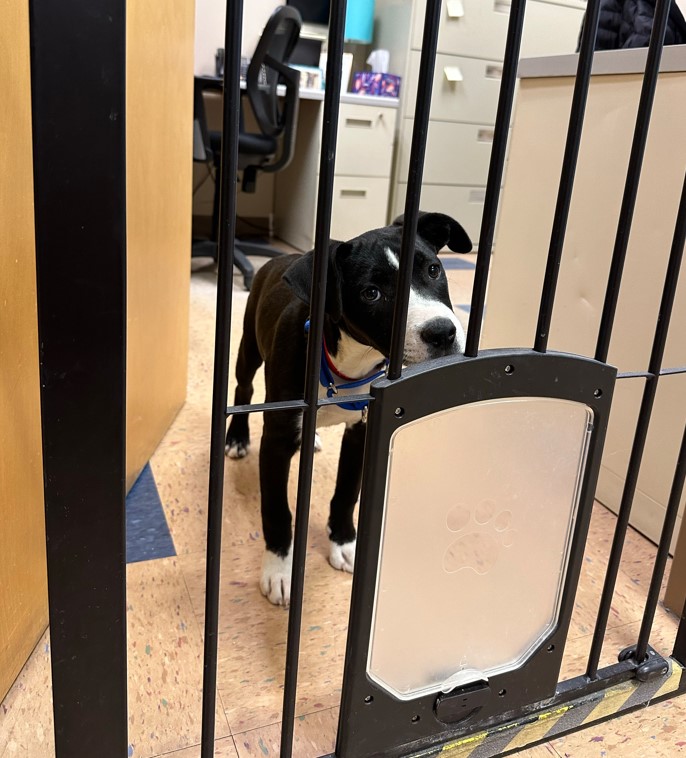Introducing Dogs to People Using a Barrier
 A barrier is an invaluable tool to set your dog up for success when being introduced to people. It allows your dog to see and smell visitors without the pressure of a physical interaction. It provides a visual reminder for those who may not understand that your dog needs more space to feel comfortable. A barrier can also be beneficial for dogs who get overexcited and aroused when people enter the home.
A barrier is an invaluable tool to set your dog up for success when being introduced to people. It allows your dog to see and smell visitors without the pressure of a physical interaction. It provides a visual reminder for those who may not understand that your dog needs more space to feel comfortable. A barrier can also be beneficial for dogs who get overexcited and aroused when people enter the home.
Set Yourself & Your Dog Up for Success
Prior to visitors arriving, review the Dog Body Language Handout so you can successfully monitor your dog’s comfort level and stress signals. Purchase high-value treats that are easily accessible to have on hand for yourself and your guests to use throughout the interaction. Before visitors enter your home, place your dog behind a barrier. The barrier needs to be tall and secure so your dog cannot jump over it, go through it, or get around it. Be sure to have a backup plan in the event your dog is unable to recover or settle in the presence of visitors. This may include having a spare room, crate, or other area to put your dog where they can be completely separated from your visitors with a high-value enrichment item, such as a peanut-butter-filled Kong.
Set Up Your Visitors
Prepare your visitors before they arrive by letting them know what behaviors your dog may display and what your expectations are of the visitor when they arrive. Instruct them to ignore your dog completely which includes not walking toward them, not talking to them, not staring at them or facing them directly, and not reaching over the barrier. There should be no attempt to engage with your dog at all until you direct them to. Ask your visitors to contact you before they enter your home so you can place your dog behind the barrier and prepare yourself.
Fearful Dogs
With dogs who are fearful it is especially important to remember that visitors should be instructed to simply ignore your dog and toss high value treats from a distance. If/when your dog begins to show relaxed, neutral body language, the barrier can be removed. Attaching a leash to your dog’s collar and allowing it to drag along the floor once the barrier is removed can be a helpful tool for you to calmly guide them back behind the barrier or into another safe space away from visitors if they become uncomfortable.
When the barrier is removed, visitors should continue tossing treats especially if they are changing their location (ex. standing up to move into a different room). They need to be mindful of their own body language, minimize quick movements, and refrain from loud vocalizations or sounds. When beginning to interact with your fearful dog, they should always toss food away from themselves and allow the dog to choose to re-approach when they are ready. They should not try to coax the dog over with the food. If the dog approaches the visitor repeatedly with a soft and loose body, the visitor can offer pets under the chin or on the chest.
If your dog continues to react by barking, growling, retreating, showing tense body language, or not accepting food while behind the barrier, do not remove it. Instead, put your dog in a separate room or ask your visitors to leave. These behaviors are an indication that your dog is very stressed, overwhelmed, and should not be around visitors at this time. We recommend reaching out to a behavior professional for additional support before attempting future introductions.
Active/Aroused Dogs
When dogs become overly excited or aroused when guests come over, it is still important to instruct your guests to completely ignore your dog. Eye contact, talking to the dog, or any other engagement with the dog may increase excitement and arousal. Treats can be tossed on the floor to help promote relaxation and orient your dog to keeping four paws on the floor. Allow visitors to enter the home and settle in before attempting to remove the barrier and allowing your dog out to greet them.
Once your visitors are equipped with high-value treats and your dog is showing relaxed, calm body language, you may remove the barrier. Attaching a leash to your dog’s collar and allowing it to drag along the floor once the barrier is removed can be a helpful tool for you to calmly guide them back behind the barrier or into another safe space away from visitors if they become uncomfortable.
Instruct your visitors to drop handfuls of treats on the floor as the dog approaches to set the dog up to successfully keep four paws on the floor when greeting the visitor. Continue to reward for desirable behavior (four paws on the floor, offering a sit, etc.), and provide them with toys and enrichment items to settle with. If your dog becomes too excited and aroused when the barrier is removed, calmly put them back behind the barrier or in a different room with a high-value enrichment item.
Additional Resources
- Check out our video on Using Barriers to Support Your Behavior Modification Plan
- If you are seeking additional support, contact our behavior department at 414-431-6173 or behavior@wihumane.org
